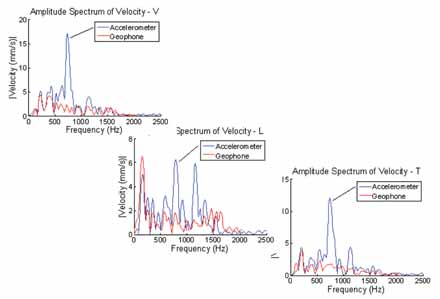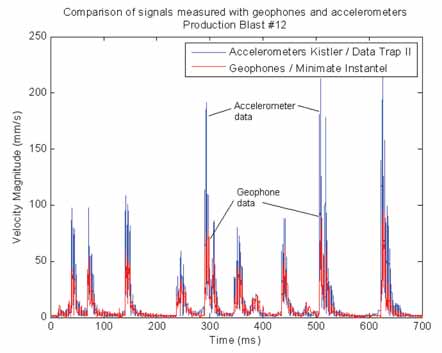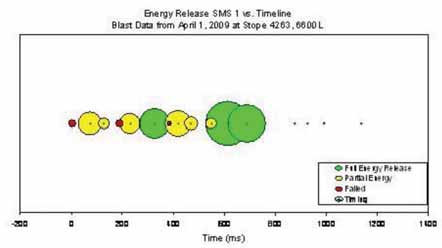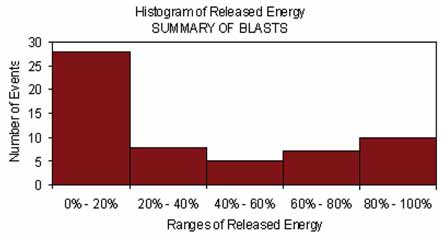An extensive blast monitoring program has
been carried out to study explosive performance and the effectiveness of blast
designs in production blasts in a deep
underground mine. Comprehensive monitoring of blasting vibrations through
multi-station high-capacity, high-frequency
accelerometers, and borehole deformation
history have been the main tools of such
analysis. The mining activity involves relatively unstressed stopes as well as highly
stressed stopes. More than 30 production
blasts have been monitored, and the
respective vibrations from close-range as
well as distant seismic stations have been
analyzed, and the vibration parameters
(amplitude and frequency) have been correlated with explosive charge weight in the
holes. The correlation between blasting
rounds and the corresponding vibration
amplitudes often have been poor for a very
significant portion of the blasts. These
point to either explosive charge malfunction in those specific blast holes, or inadequate blast design, or the effect of high insitu stresses, or any combination thereof.
Introduction
Misfires or any other type of malfunction in
a surface blast, be it construction, quarrying, or large open-pit operation, is easily
detected. Once the source has been identified, remedial action can be taken to ensure
productivity and safety (Farnfield, 1966;
Segarra et al, 2009). However, the situation
in an underground operation is very different, especially in stope blasting or any other
mass mining operations. In such cases, fan
drilling and vertical retreat mining (VRM)
are the usual methods employed. The boreholes in this case could have a single column of explosives or incorporate several
explosive decks with various delays.
Any missing or misfired holes in this
case are extremely difficult to detect after
the blast because it is not possible to
uniquely identify the source of a poor
blast. In such cases, the presence of oversize fragments cannot be ascribed to the
blast in question.
Standard blast monitoring through
commercially available vibration monitoring is sometimes employed to monitor
some of these blasts, but for reasons
explained in this article, it is not possible
to carry out a truly diagnostic analysis of
such blasts and identify any particular malfunctioning blast hole.
Experimental Program
The study was carried out at a deep underground mine. A typical cross section of a
stope blast design at the mine is shown in
Figure 1. The borehole diameter was 162
mm, with varying depths as shown. A booster-sensitive packaged water-gel slurry explosive with a density of 1.15 g/cc was used
throughout. The quoted effective RWS (i.e.
gas expansion up to 100 MPa) by the manufacturer of this product was 96, with a
VOD of up to 4,900 m/s. Each explosive column is bottom initiated with a 450 g
Pentolite booster. Blast monitoring at the
mine is usually carried out with a commercially available monitor (Instantel Minimate)
employing three-component geophones.
The first step in this study was to ascertain the adequacy of this vibration monitor
in assessing the production blasts at the
mine. For this purpose, a comparative study
was carried out with high-frequency
accelerometers placed side by side with
Minimate. The usual precautions were taken
in mounting the geophones and the
accelerometers (Farnfield, 1996) on to the
surface of the rock underground. The
accelerometers had an upper frequency
range in excess of 10 kHz and the usual
acceleration limit was 100 g. The placement
of the two types of monitors (i.e., geophones
and accelerometers) is shown in Figure 2.
The data for the accelerometer recording
was carried out with both an analog data
acquisition system with a bandwidth of DC
to 45 kHz, and a digital data acquisition system with a sampling rate of 1MHz.
Analysis
A typical vibration record obtained with the
geophones (i.e., Minimate) along longitudinal, transverse and vertical directions is
shown in Figure 3. Individual delay rounds
are clearly seen in the vibration record,
despite the usual scatter in firing times.
The highly unequal particle velocity amplitudes among the delay rounds are clearly
evident. The data highlights the need for
multi-axial recording of vibrations, but the
pronounced variations along each axis can
be attributed only partly to the varying
charge weights in the holes.
A more diagnostic comparison between
high-frequency accelerometer recordings
and those by geophones is illustrated in
Figure 4 for the same blast. Closer examination of the two records, i.e., particle
velocity records from the geophones and
integrated accelerometer data, from the
same blast shows only a qualitative agreement between the two types of recordings.
The peak particle velocity values obtained
by integration of the accelerometer data
show consistently higher amplitudes than
those obtained with direct geophone recordings, despite both geophones and accelerometers placed in the same location.
The difference between the two types of
recordings is further amplified when one
examines the frequency content of the individual wavelets corresponding to each delay
round. The respective frequency spectra of
particle velocity from the geophone and
accelerometer recordings are shown in
Figure 5, for a single delay round. Whereas,
the energy content in the geophone recording is seen to be confined below 300 Hz,
the same particle velocity values obtained
from integration of accelerometer data
shows the maximum amplitude closer to
1 kHz or higher. In most cases the peak particle velocity derived from accelerometer
data greatly exceeds those obtained by geophone recordings.
These differences have serious implications when one compares the resultant particle velocity records obtained by the two
modes of recording. This is illustrated in
Figure 6, which shows the comparison
between the resultant particle velocity for the geophone and accelerometer recordings for a typical production blast with
pyrotecnic delays. The scatter in firing
times between the delay rounds is obvious
but to be expected. Similarly, the varying
particle velocity amplitudes observed with
both geophone recording and accelerometer recording among the events is to be
expected, but due only partly to varying
charge weights and the travel paths for the
seismic waves, and related geological factors. The more serious observation is the
fact that for the same charge weight per
delay and distance, the peak particle velocity obtained from accelerometer recording
is often greater than by a factor of two compared to peak particle velocity obtained
with geophone recording.
For example, the event at approximately 300 ms shows the resultant particle
velocity to be 80 mm/s, whereas the data
derived from the accelerometer station at
the same location shows it be 190 mm/s.
Similarly, the event arriving at 500 ms, the
geophone data yields a resultant particle
velocity of 90 mm/s compared to 220
mm/s for the corresponding accelerometer
recording. This difference cannot be
explained away simply because of charge
weight differences or the geological factors
involved, as both accelerometer recording
and geophone recordings correspond to
identical charge weights, geological conditions and seismic travel paths.
Particle Velocity Amplitudes
and Explosive Energy
The recorded vibration amplitudes can also
be related to the explosive energy yield at
the source, as the radiated energy can be
shown to be proportional to the square of
the amplitude of the particle velocity.
Throughout this analysis it is assumed that
the seismic energy (i.e., blast vibration
energy) is directly related to the total explosive energy released in the borehole. This is
a valid argument so long as the source function remains unchanged, i.e., there is no
change in the type of explosive used, or the
decoupling condition in the borehole is
changed, or there is a significant change in
the initiation mode employed in the blast
that would result in a drastic change in the
energy partitioning between shock and gas
energy from the explosive (Mohanty, 2009).
On this basis, the energy yield from the various explosive loads for the blast in question
with accelerometer data is shown against
designed delay times is shown in Figure 7.
For a true comparison of energy levels,
the derived energy values have been linearly
scaled (i.e., normalized) with the corresponding charge weight for each delay round, as
in earlier works (Mohanty et al., 1997). The
effect of varying distances to the corresponding explosive charges on the amplitude of
the particle velocity is considered minor in
this case because of the relatively large distances involved between the stope blast and
the monitoring stations. Therefore, the energy yield values shown in Figure 7 would represent the actual specific energy estimates
from each of the explosive columns in the
blast, i.e., specific energy per kg of charge.
The radius of each circle in Figure 7
represents the relative specific energy/kg with respect to the maximum value
obtained for selected blasts, irrespective of
the delay time recorded. If each explosive
charge in the blast were to yield the same
specific energy (i.e., MJ/kg), as expected,
all of the circles shown in the figure should
have had the same radius, since there were
no variations in explosive type or its diameter or its mode of intiation. However, as
the figure shows there is considerable variation in specific energy release from the
various explosive charges, with values ranging from 100% to total failure.
For this study, a very conservative criterion of specific energy release is applied,
i.e., 0% to 20% of the expected energy
release (with respect to the normalized maximum particle velocity amplitude) considered a failure, >20% to <40% considered a
partial energy release, and >40% to 100%
considered full energy release. On that
basis, only three holes in the blast appeared
to release full energy, six only partial energy,
and seven holes with negligible energy.
Another way of illustrating the specific energy release figures for a number of regular
stope blasts is shown in Figure 8. It shows
28 blast holes to release less than 20% of
the expected explosive energy, and only 22
blast holes yield nearly the full energy (i.e.,
40% to 100% of the expected energy).
Discussion and Conclusion
There is considerable data available in
open literature on measurement and analysis of blasting vibrations from mining and
quarrying operation. Much of this information, however, relates to estimation of damage potential to civil structures and to a
lesser extent, to pit slope stability and
blast-induced damage to rock mass, and
detecting obvious misfires or firing time
deviations in a blasting round. In contrast,
near-field vibration measurements and
their diagnostic use in examining explosive
performance and blast design has received
much less attention (Mohanty, 1997;
Fleetwood et al, 2009).
The results of this study show there is
significant discrepancy between the expected vibration amplitudes in terms of
specific vibration energy released and that
actually measured in the stope blasts
under investigation, all other conditions
remaining the same. In this case, aside
from the usual firing time deviations with
pyrotechnic detonators, typically more than
one-third of the blast holes release very little energy in the form of transmitted seismic energy over multiple accelerometer stations. As is well known, low vibration
amplitudes can be caused by a variety of
causes such as varying geology (Fleetwood
and Villaescusa, 2011), poor loading practice, hole deviation resulting in dislodgement of or damage to explosive charges in
adjacent blast holes, or the quality of the
explosive products itself. However, these
apparent blast malfunctions cannot be
attributed to the above causes in the great
majority of the production blasts in question, especially since the blasts were monitored at multiple accelerometer stations.
Although none of the above factors can
be ruled out in some individual cases, the
widespread malfunctions exemplified in this
study point to a more systemic cause for
these apparent failures such as lithologic
factors. The effect of the latter is evident
from wide-scale blast hole deformation due
to high ambient stresses that are characteristic in some of the stopes at this deep mine,
and is part of the continuing investigation.
The study also aims to provide not only superior blast diagnostics but also improved blast
designs to counter these deficiencies.
Acknowledgement
The authors are grateful for the financial
assistance provided by the National
Science and Engineering Research Council
of Canada and Vale Canada during the
course of this research. In addition, the
extensive assistance provided by Vale for
field monitoring of vibrations in one of their
underground mines is also gratefully
acknowledged.
Mohanty and Zwaan are professors at the
Lassonde Institute of Mining at the
University of Toronto, and Malek is a rock
mechanics engineer working with Vale’s
Copper Cliff mine in Ontario, Canada. This
article was adapted from a paper Mohanty
presented at the 2013 International
Society of Explosives Engineers conference, which took place during January in
Nashville. The next ISEE conference will be
held in Denver, Colorado, February 9-12,
2014 www.isee.org).
References
Farnfield, R., 1996,”So you think you are
monitoring peak particle velocity”; Proc.
12th Symp. on Ann. Symp. on Explosives
and Blasting Res.; Int. Soc. of Explosives
Engrs.; p. 13-20.
Fleetwood, K.G., Villaescusa,E., Li, J.
and Varden, R.; 2009,“Comparison of traditional near-field vibration prediction
models with three-dimensional vibration
scaling and blast wave energy”; Proc. 9th
Int. Symp. on Rock Fragmentation by
Blasting (FRAGBLAST 9), Sanchidrian,
J.A.;ed.; CRC Press, p. 579-588.
Fleetwood, K.G. and Villaescusa, 2011,
“Measured results of the influence of of a
large- scale fault on blasting vibrations in
sub-level open stoping”; Proc. 37th Ann.
Conf. on Explosives and Blasting Tech.;
Int. Soc. Explosives Engrs., ISEE, p. 1-13.
Mohanty, B. and Yang, R.,1997,
“Blasting vibrations and explosives performance”; Proc. 13th Ann. Symp. on
Explosives and Blasting Res., Int. Soc.
Explosives Engrs.,ISEE, p.15-28.
Mohanty, B.; 2009, “Intra-hole and
inter-hole effects in typical blast designs
and their implications on explosives energy
release and detonator delay time—A critical
review”; Proc. 9th Int. Symp. on Rock
Fragmentation by Blasting (FRAGBLAST 9);
Sanchidrian, J.A; ed., CRC Press, p.23-31.
Segarra, P, Sanchidrian, J.A., Lopez,
J.M.; Querol, E. and Guiterrez, J., 2009,
“Assessment of the error of blast vibration
measurements”; Proc. 9th Int. Symp. on
Rock Fragmentation by Blasting (FRAGBLAST 9); Sanchidrian, J.A; ed., CRC
Press, p.551-560.







